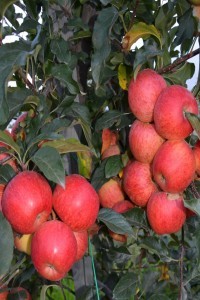Determination of root properties of saplings belong to two boxwood species (Buxus sempervirens and Buxus balearica) by image processing technique
Determination of root properties of saplings belong to two boxwood species (Buxus sempervirens and Buxus balearica) by image processing technique
The study was carried out to determine the root architectural characteristics of the one-year saplings of two species of boxwood (Buxus sempervirens L. and Buxus balearica Lam.), which are endangered and natural plants of Turkey, in the greenhouse environment using the WinRhizo root analysis program and scanner. Total root length (cm), root surface area (cm2), root volume (cm3), average root diameter (mm), number of tips, number of forks and number of root crossings were determined in the study. According to the results of the study, the increase in temperature and decrease in humidity values in the second year of both species were effective on the root architectural features. As a result of this effect, the second year root length (3810 cm), number of root tips (2299), number of forks (7007) and number of root crossings (696) increased, root diameter (1.4 mm), root surface area (2158 cm2) and root volume (8 cm3) decreased. As a result, it has been concluded that species can make changes in their root parameters to adapt to different conditions and their adaptability is high. In general, the best results in root architectural parameters were obtained from Buxus balearica on the basis of species
___
- Adams, F., & Moore, B. L. (1983). Chemical factors affecting root growth in subsoil horizons of coastal plain soils. Soil Sci. Soc. Am. J., 47: 99-102.
- Barley, K. P. (1970). The configuration of the root system in relation to nutrient uptake. Adv. Agron. 22:159-201.
- Boldrin, D., Leung, A. K., & Bengough, A. G. (2017). Correlating hydrologic reinforcement of vegetated soil with plant traits during establishment of woody perennials. Plant Soil, 1-15.
- Bucksch, A., Burridge, J., York, L. M., Das, A., Nord, E., Weitz, J. S., & Lynch, J. P. (2014). Image-based high-throughput field phenotyping of crop roots. Plant Physiol. 166, 470-486.
- Davis, (1982). “Flora of Turkey and the East Aegean Islands”, Volume Seven, Edinburgh at the University Pres, 22 George Sguare, Edinburgh, ISBN:0852243960, 630-632.
- Dorairaj, D., Suradi, M. F., Mansor, N. S., & Osman, N. (2020). Root architecture, rooting profiles and physiological responses of potential slope plants grown on acidic soil. PeerJ, 8, e9595.
- Gökmen, H. (1977). Kapalı Tohumlular (Angiospermae) 2. Cilt. Orman Bakanlığı yayınları Sıra No. 616, Seri No. 55, Ankara, s. 38-609.
- Instuments, R. (1996). WinRhizo V3. 9 Reference. Regent Instruments Inc., Quebec, Canada.
- Judd, L. A., Jackson, B. E., & Fonteno, W. C. (2015). Advancements in root growth measurement technologies and observation capabilities for container-grown plants. Plants, 4(3), 369-392.
- Karaağaç, O., Kübra, T. A. Ş., Özgen, R., Kanal, A., & Balkaya, A. (2020). Capsicum türlerinin kök yapılarının incelenmesi ve kök özellikleri yönünden karşılaştırılması. Yüzüncü Yıl Üniversitesi Tarım Bilimleri Dergisi, 30(2), 266-279.
- Kayacık, H. (1981). “Orman ve Park Ağaçlarımızın Özel Sistematiği”, II. Cilt Angiospermae, II. Baskı İ.Ü. Orman Fakultesi Yayınları, İstanbul, 145-148.
- King, J. S., Albaugh, T. J., Allen, H. L., Buford, M., Strain, B. R., & Dougherty, P. (2002). Below ground carbon input to soil is controlled by nutrient availability and fine root dynamics in loblolly pine. New Phytologist, 154(2), 389-398.
- Köhler, E. (2007). In: Kobinski, K. (Ed.), Buxaceae. The Families and Genera of Flowering Plants. Springer, Berlin, Heidelberg, New York.
- Larson, P. D. (1996). Boxwood: İts History, Cultivation, Propagation and Descriptions. Boyce, VA: Foliar Press VI.
- Paez-Garcia, A., Motes, C. M., Scheible, W. R., Chen, R., Blancaflor, E.B., & Monteros, M.J., (2015). Root traits and phenotyping strategies for plant improvement. Plants, 4: 334-355.
- Pregitzer, K. S. (2002). Fine roots of trees–a new perspective. New Phytologist, 154(2), 267-270.
- Sarı, Ö., & Çelikel, F. G. (2019). Türkiye’nin Şimşirleri (Buxus sempervirens ve Buxus balearica) ve Mevcut Tehditler. I. International Ornamental Plants Congress – VII. Süs Bitkileri Kongresi, 9-11 Ekim 2019, Bursa, S. 383-393.
- Sarıbaş, S., Balkaya, A., Kandemir, D., & Karaağaç, O. (2019). The phenotypic root architectures and rooting potential of local eggplant rootstocks (Solanum melongena x Solanum aethiopicum). Black Sea Journal of Agriculture, 2(3), 137-145.
- Stokes, A., Atger, C., Bengough, A. G., Fourcaud, T., & Sidle, R. C. 2009. Desirable plant root traits for protecting natural and engineered slopes against landslides. Plant and Soil, 324(1), 1-30.
- Türkyilmaz, E. 2004. “Şimşir (Buxus sempervirens L.) Odununun Bazı Morfolojik ve Fiziksel Özellikleri”, V. Ulusal Orman Fakülteleri Öğrenci Kongresi, Bildiriler Kitabı, 2. Cilt-Orman Endüstri Mühendisliği, K.T.Ü. Orman Fakültesi, Trabzon, pp.18-22.
- Wraith, J. M., & Wright, C. K. 1998. Soil water and root growth: Soil Environment and Root Growth. HortScience, 33(6), 951-959.
- Yang, Y., Chen, L., Li, N., & Zhang, Q. 2016. Effect of root moisture content and diameter on root tensile properties. PLoS One, 11(3), e0151791.
- Zou, Y. N., Wang, P., Liu, C. Y., Ni, Q. D., Zhang, D. J., & Wu, Q. S. 2017. Mycorrhizal trifoliate orange has greater root adaptation of morphology and phytohormones in response to drought stress. Scientific reports, 7(1), 1-10.
- Yayın Aralığı: Yılda 2 Sayı
- Başlangıç: 2019
- Yayıncı: Burhan ÖZTÜRK
Sayıdaki Diğer Makaleler
Effect of pollinator cultivars on nutrient content in some Turkish hazelnut cultivars
Hüseyin İrfan BALIK, Neriman BEYHAN
Hakan KARADAĞ, Kenan YILDIZ, Hakan Mete DOGAN
Ömer SARI, Fisun Gürsel ÇELİKEL
Effect of land configuration ways on soil moisture and sesame seed yield in Ethiopia
